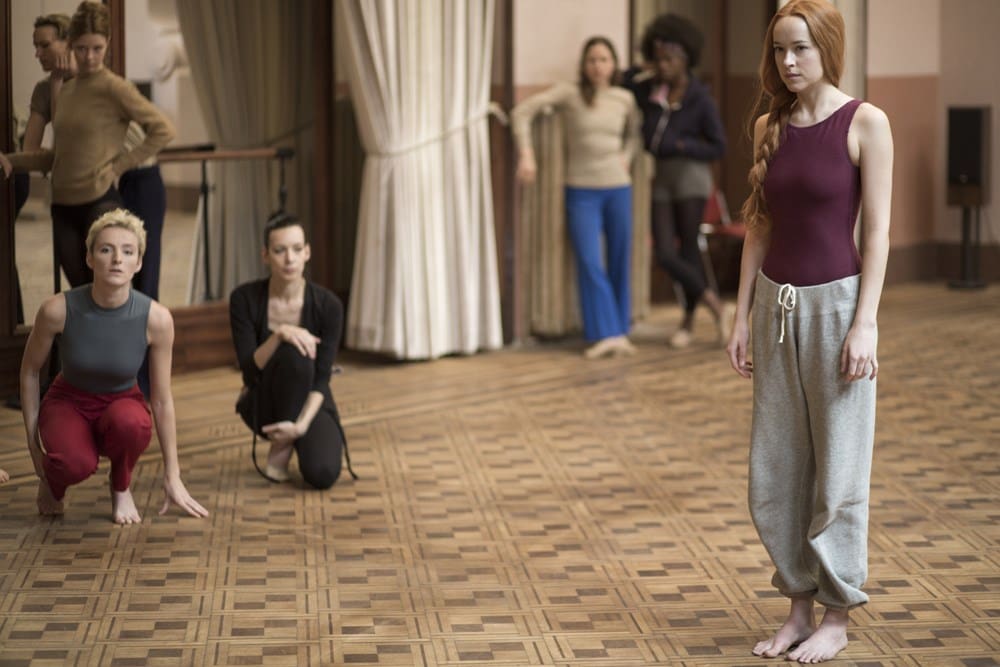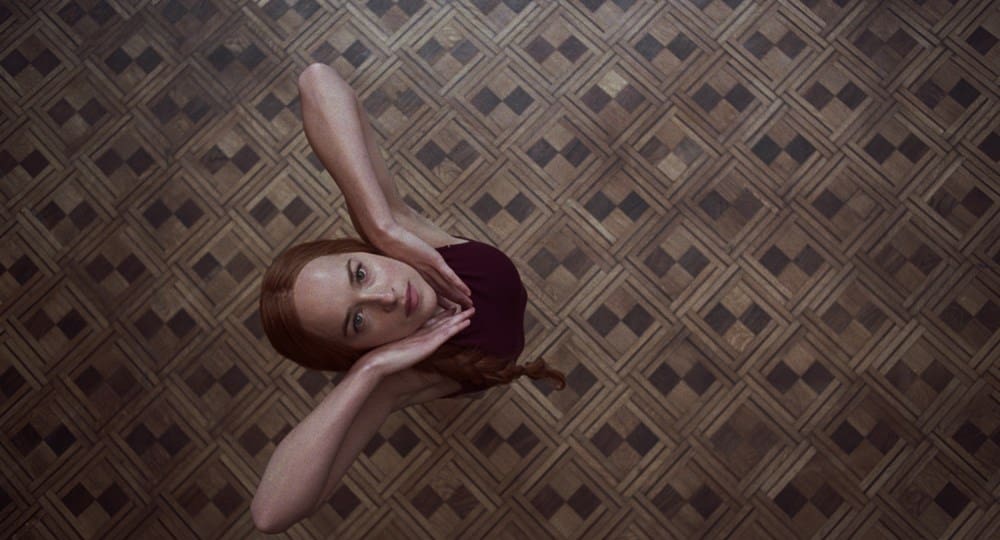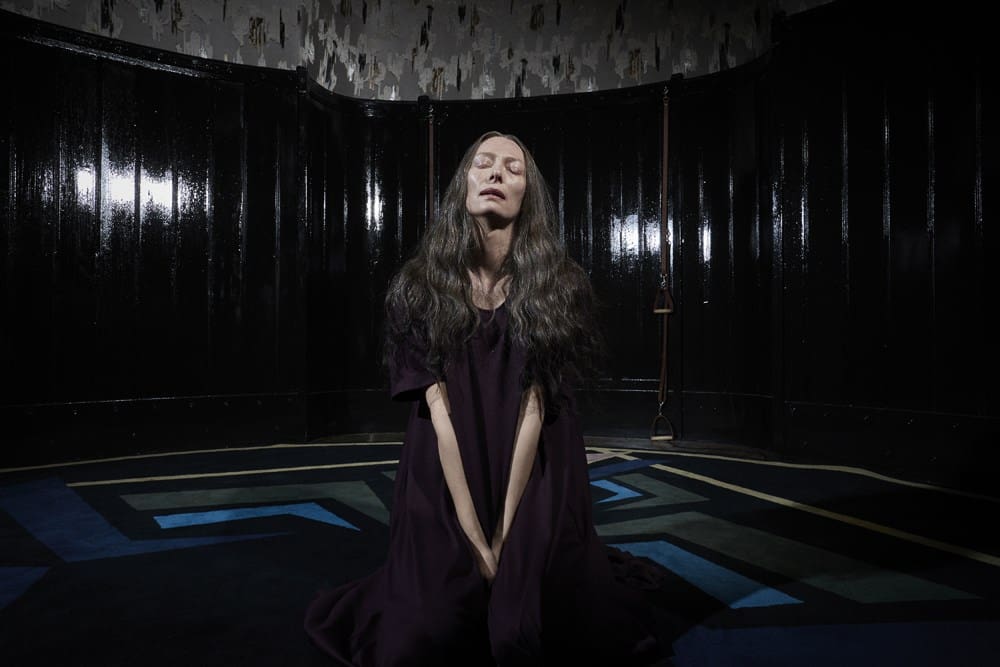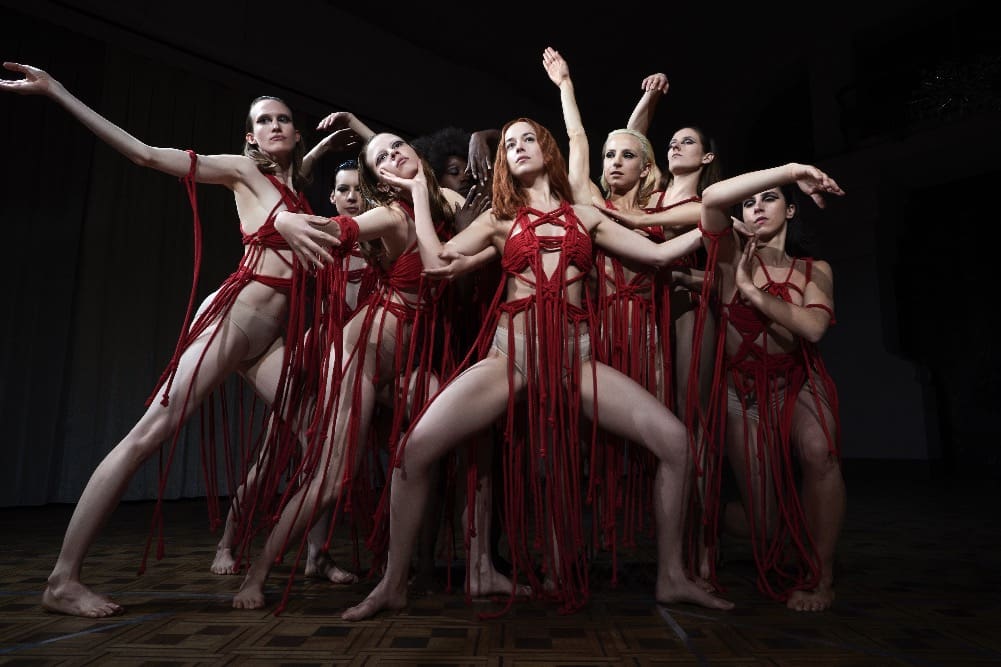
***Massive Spoilers Ahead***
Nowhere is the gender inequality in film reviewing more evident than in a press screening. I don’t think I’ve ever been the only woman, but I wouldn’t be surprised to learn men usually outnumber us 5 to 1. That was probably the ratio a few weeks ago, when I sat in an uncharacteristically packed theater to watch Call Me by Your Name director Luca Guadagnino’s remake of Dario Argento’s 1977 film, Suspiria.
There’s often a sort of genial peacocking amongst the critics before the lights dim and since we were some of the first to see the movie outside of various festivals, the men in the room were in rare form. The worst bragged loudly–to both his co-worker and the rest of the room–that a certain Oscar-winning actress would be coming to their office in a few days and then ignored his co-worker’s pleas to lower his voice when he made a joke about how excited that co-worker’s dick would be to meet her.
That guy did shut up when the movie started (though not before loudly clearing his throat multiple times to emphasize that it was only through his magnanimity that he would follow the basic tenets of movie theater decorum) and the rest of the boys followed suit. In fact, as the film went on, the men in the audience seemed chastened by what, to me, felt like a glorious, perhaps even empowering expression of female rage.
Women’s anger is having a moment. Writers Soraya Chemaly and Rebecca Traister released books about it in the last few months, women-led protests seem to happen almost daily and the #MeToo Movement is a sustained, collective scream of pain and sadness that’s shaken the very foundations of this country. Journalist Erin Keene probably put it best a few months ago when she said on Twitter, “Every woman I know has been storing anger for years in her body and it’s starting to feel like bees are going to pour out of all of our mouths at the same time.”
While there are no bees in Guadagnino’s Suspiria, there is blood—lots of it. Though Argento’s film was often gory and disturbing (the razor wire room is still one of the great shocks of the horror genre), its cheap practical effects and dubbed dialogue make it easy to distance yourself from the horror onscreen. Guadagnino’s film does not have that problem.

Set in 1977 West Berlin, Guadagnino and cinematographer Sayombhu Mukdeeprom have created a much gloomier film, devoid of the almost Technicolor blues and reds and disorienting geometric patterns of Argento’s world. This version is grim and quietly dangerous, filled with dirt and muted colors that are only broken up by sharp reds.
We first encounter that gloom through Chloë Grace Moretz’s character, Patricia. Rain-drenched and shivering, she storms into the movie the same way her character walks into her psychologist’s office. She is clearly manic, zipping around the room so quickly and constantly that the camera almost seems to have trouble tracking her.
She mumbles to herself in both English and German and her anxiety makes both the audience and her psychologist, Josef Klemperer (87-year-old newcomer Lutz Ebersdorf plays the character according to the credits, but it’s obviously Tilda Swinton in old-age make-up) anxious too. We and the doctor must lean in to hear her, so it’s jarring, then, when her voice suddenly rises or worse, when some loud sound effect plays.
There and elsewhere, every bump and breath is as loud as a thunder clap and the constant rain not only justifies the gloomy color palette, but creates a constant cacophony of background noise. Much like Daren Aronofsky’s mother!, Guadagnino creates a deliberately abrasive soundscape that works like ASMR in reverse. Our sense of hearing is constantly engaged, and the loudness of usually unnoticeable sounds triggers an almost primal alertness.
Where Argento’s film played coy about whether Suzy (Jessica Harper, who also plays Klemperer’s long-lost wife here) was at the center of a nefarious witch plot, Patricia’s behavior and everything about the way she’s introduced lets the audience know the Markos Coven is real even before our protagonist, Susie (Dakota Johnson), shows up.
That said, Susie’s first scene, in which she auditions to become part of the Markos Dance Company that acts as the coven’s façade, is the film in full sensory overload mode. Since she’s never danced professionally, the witches only let Susie audition so they can laugh at her, but as Johnson (and then presumably her double, though Walter Fasano’s editing is so seamless, it’s hard to tell) dances, the atmosphere changes. Choreographer Damien Jalet’s work is athletic and emotional–what primal scream therapy might look like in dance form–and, unaccompanied by music, the only sounds are the rhythm of Susie’s breath and the movements of her body.

Every slam of her hand or shuffle of her foot against the ground, every jump or spin feels ritualistic and the assembled witches don’t just sense it, they seem moved by it in a way that borders on sexual. Susie’s pull is so strong, in fact, that Swinton’s other major character, chief choreographer, Madame Blanc, is drawn to the room by it.
Still, while there’s an element of danger to that scene, we don’t understand how sinister the Markos company really is until the next time Susie dances. After Olga (Elena Fokina) storms out of rehearsal for one of Blanc’s most famous and difficult pieces, Volk, Susie volunteers to dance “the protagonist.” Though it initially rings false that the ambitious and more experienced members of the company not only don’t volunteer, but balk when asked, it quickly becomes clear why: this isn’t just a dance, it’s how the Markos Coven casts its spells. “Stop if you get dizzy,” Mme. Blanc warns before she grasps Susie’s hands and then her feet, seemingly transferring some sort of magic in the process.
The victim of that magic is Olga, who is trying to heed Patricia’s warnings and leave the company forever when she encounters two of the older witches on her way out. They stare intently at her and suddenly, something starts to leak from her eyes, not tears per se, but something more viscous, clearly unnatural and unstoppable. From there, something leads her to the same mirror-lined room where we first watched Susie audition and it’s there that the film’s most disturbing passage begins.
As Susie dances, every move she makes affects Olga. As she throws out her arm, Olga flies across the room and smashes into the mirrored wall. When Susie kicks her leg, Olga crumples to the floor, her bones cracking in a nauseating way. And when Susie twists her hands around at the wrists, Olga’s body contorts unnaturally, causing bile to dribble from her mouth and urine to soak her pants. It’s awful and difficult to watch without turning away, but the editing is timed so perfectly that the whole scene inspires equal parts disgust and fascination. From that point on, anytime a character enters that room or the company–especially Susie–dances, the audience collectively tenses in anticipation of some horror.

Though Argento’s original contains far less dancing, it builds the same kind of tension (though I’d argue not as well) through an ever-worsening series of deaths and strange goings on. The longer Suzy stays, the more the evil behind the Tanz Dance Company becomes something she has to defeat. As Professor Milius (Rudolph Schündler), an expert on the occult, explains to her in the film’s last act, the company’s witchcraft can “only do harm.” The only way Suzy can defeat the evil is to kill Helena Markos, the coven’s leader and Suzy’s hero moment–and the film’s resolution–only come when she succeeds.
At first, it looks like Klemperer may end up filling the same role as Milius. After all, driven by his guilt over dismissing Patricia’s fears, he later tries to convince Sara (Mia Goth), another dancer and Susie’s friend, that there’s something evil going on at the Markos Dance Company. Though he may not necessarily believe there’s real magic, he does argue that the coven’s collective delusions–which he likens to both religion and Patricia’s involvement with the Red Army Faction–could be convincing them to do horrible things. And while Sara and Patricia are certainly the victims of the coven’s actions, Susie is not.
When the film starts, Susie is inexperienced and still struggling to move past her Mennonite upbringing in Ohio—a word she says with such profound embarrassment that it‘s surprising she doesn’t apologize. However, as the film goes on, rather than becoming frightened like Suzy, she becomes more self-assured. The more Susie sees, the more she already seems to understand.
When she catches some coven members hypnotizing the detectives looking into Patricia’s disappearance (laughing maniacally while the audience squirms as they poke the men’s penises with the hooked implement they used to remove the still-breathing Olga from the mirror room earlier), she’s confused, but she ends up laughing too. She’s also the first one to call the dancing the Markos Company does “spells” and the coven doesn’t so much punish Olga through Susie’s dancing as not realize her movement is seducing them until it’s too late.
As played by Johnson, Susie is at once knowing and an ingenue and Johnson’s work is so subtle that it’s easy to miss how clever it is until you already know what she’s trying to do. Still, it’s not exactly surprising that Johnson sells Susie’s arc so well. She traced a similar trajectory in her and Guadagnino’s first collaboration, A Bigger Splash, going from a seemingly unknowing Lolita-type to a full-blown monster. She also did the whole thing in reverse in her other recent release, Bad Times at the El Royale. However, it’s the film’s final beats where she helps the movie not only subvert our expectations but re-frame everything we’ve seen before.
When Susie first enters the underground cavern where the film’s climax takes place, it looks like a nightmare from a Hieronymus Bosch painting. Naked women arrange themselves in strange tableaux, wailing as they begin to dance. In the corner sits Helena Markos (Swinton, again), a cancerous, barely-living mass of mottled flesh that couldn’t help but want to inhabit supple young Susie as her vessel. Standing there in a sheer robe, her red hair down and wavy, it’s no wonder Mme. Blanc can’t bear to see her prodigy destroyed. But Susie isn’t afraid, she’s excited to become part of this ritual, and just when we and Blanc begin to fear that she’s a naive fool taken in by something she doesn’t understand, she reveals her true form.
Markos may claim to be Mother Suspiriorum, one of the ancient witches in whom this coven believes, but it’s really Susie, and she is not happy that a coven acting in her name has been following a pretender. In most horror movies, the ensuing bloodbath would be the ultimate nightmare—the manifestation of all the unworldly evil the film has made us imagine up to that point. But the most incredible trick Guadagnino’s film pulls is to give us a whole new kind of cathartic destruction.
The tall, black, mouth-less, seemingly tar-covered figure that emerges from the ground to enact Susie’s will isn’t pure evil, it’s justice. Suspiriorum doesn’t kill indiscriminately, she kills the witches who supported Markos in her quest to gain eternal life by stealing girls’ bodies. The women left behind are the true believers, the ones who wanted to follow Suspiriorum’s true disciple, Mme. Blanc.
Susie’s baptism by blood isn’t just violent, it’s also cleansing. After taking care of the bad witches, Susie approaches the zombie-like ciphers of Sara, Olga and Patricia. She asks each girl, disemboweled but still kept alive by magic, what they want and then mercifully gives them the sweet release of death when they request it.
Such an ending is unimaginable in Argento’s film and there are a lot of reasons for that, but perhaps the most important is that in Guadagnino’s film, a man never tells Susie that the coven is dangerous. She comes to understand witchcraft on her own terms and the result is totally different than what Suzy experiences. And while that’s obviously a simplistic explanation, it’s hard to ignore that excluding men from this story not only changes its trajectory but gives it a deeper meaning.
Klemperer may be a man, but he’s played by Swinton and while that initially seemed like a strange bit of stunt-casting on Guadagnino’s part, it’s really the most potent expression of the way this film excludes men from taking any active role in the story. The only men we see are either pawns the witches use for their protection and amusement (the detectives) or unwitting witness to their rituals who are unable to stop them (Klemperer). This is a story about female power and Susie’s discovery of hers isn’t a downfall, it’s a liberation both personal and collective.
Part of what allowed the coven to be corrupted by Markos in the first place was that it was forced to go underground during World War II. We don’t get to see much of Susie and the coven post-ritual, but it’s hard to imagine Suspiriorum hiding her power again. Susie’s mother, whom we see in flashback, may have claimed on her deathbed that Susie was the sin that she unleashed upon the world, but if what Susie does is sin, then it is also the most beautiful, cathartic benevolence too. How else are we to take her visit to Klemperer in the film’s epilogue? She not only erases his memories of the Markos witches and the way they manipulated him, but frees him of the guilt of inadvertently causing his wife’s death during the war.
It’s a beautiful, cathartic moment, but I confess, at this precise sociopolitical moment, I, and I suspect many other women, aren’t quite ready for that kind of forgiveness. Klemperer may have learned the hard way what happens when you ignore women’s warnings or dismiss their trauma, but not all men have learned the same lesson. Not to put too fine a point on it, but there’s a reason Guadagnino refers to religion, Patricia’s involvement with the RAF and the coven as “collective delusions” and then brings in Susie’s violent but ultimately benevolent mother figure to wipe it all away. What spoke to me in Suspiria’s final moments wasn’t the absolution, but the anger-fueled reckoning that eventually led to it.
By the time the film began its bloody, batshit denouement, I was elated. And I wanted to literalize it in the same way Suspiria does: by taking away the ownership the men in the audience felt over that space and claim it for myself. I wanted to stand up, plant my feet on the ground and let out a Black Canary scream until I brought the whole building down. Like Susie, I wanted to reach out my hand and annihilate everyone in the room except, perhaps, the guy literally cowering in the seat next to me (a seat which was mine until he stole it from me while I went to the bathroom) so that he could tell stories of my righteous fury to other men after.
In the same way that the ending of 2015’s The Witch suddenly switched from the terror of the devil to making it look like accepting his offer to “live deliciously” was the most exquisite kind of freedom, there is something bizarrely and perhaps inexplicably empowering about the end of Suspiria. Watching Susie finally break free of the expectations of goodness placed onto her by everyone she’s ever met and fully become the person she was supposed to be all along is both terrible and wonderful to behold.
At least that’s how I read it.
Based on the baffled, somewhat desperate conversations amongst some of the critics after the screening, what Guadagnino and particularly Johnson do in those final scenes may simply be too extreme and obtuse for some viewers to accept what it all means. To me, both the original Suspiria and this reimagining are about dangerous women, but the first sees powerful women in the traditional way: as evil, dangerous and deserving of death. Guadagnino’s film sees female power through a post-Feminist Movement and post-#MetToo lens. And sure, sometimes gaining power means you have to destroy some of your sisters in the process, but that destruction is ultimately cleansing, and the world is better for it.
I admit: that reading won’t work for everyone. Hell, maybe I took the movie too personally. Maybe seeing Suspiria for the first time mere days before the Kavanaugh hearings and after a year spent watching women expose their trauma to the world in hopes of convincing powerful men to acknowledge their humanity tapped into a bottomless well of rage that’s filled up over a lifetime of being a woman. Still, it’s hard to deny there’s something hopeful in the film’s final minutes. The audience may know the various twists and turns history will take post-1977, but at least the rain has stopped. The sun is out, the world is in bloom and Dakota Johnson has a power the likes of which the world has never seen. And there are still two more Mothers to come. I can’t think of anything more hopeful.

